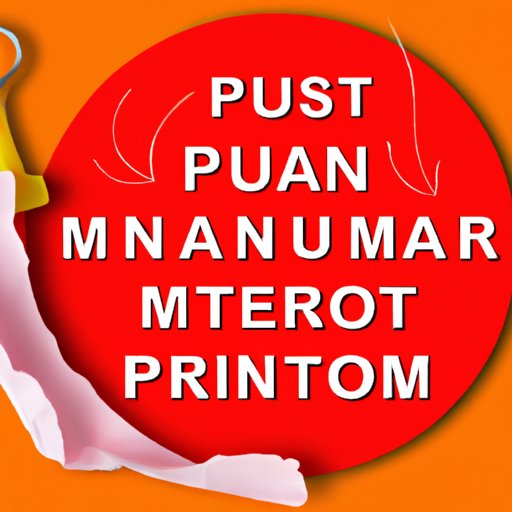Introduction
Menstrual periods are a normal part of life for most women, but the associated pain and discomfort can make them a dreaded monthly occurrence. While some women may experience smooth periods with no discomfort, for others, the first day of their period can be excruciating. The good news is, it’s entirely normal to experience period pain, but it’s essential to understand why it happens and how to manage it. This article will delve into the science behind period pain, coping strategies, causes, and remedies to help women better understand their menstrual cycle.
The Science Behind Why the First Day of Your Period Hurts So Much
The Role of Hormones
The menstrual cycle is regulated by hormones, namely estrogen and progesterone. During the menstrual cycle, the uterus’s lining thickens, preparing for a potential pregnancy in case an egg is fertilized. If no egg is fertilized, the hormone levels drop, leading to the uterus lining shedding and being released through the vagina as blood. This process can cause discomfort and pain, with the severity varying among women. The hormones also play a role in pain perception, which can contribute to menstrual pain.
Uterine Contractions
During the menstrual cycle, the uterus contracts to help shed its lining. These contractions can cause discomfort and pain, with the first day of the period being the most painful. The pain is typically felt as cramps in the lower abdomen and often radiates to the lower back and thighs. The intensity and duration of the pain vary from woman to woman.
Inflammation
The uterus releases prostaglandins during menstruation to help facilitate the shedding of the lining. These hormone-like substances can cause inflammation in the uterus, leading to cramps, nausea, and vomiting. The severity of the inflammation varies, leading to varying levels of discomfort and pain.
Coping with Period Pain: Tips and Tricks for the First Day of Your Menstrual Cycle
Pain Management Strategies
Over-the-counter painkillers such as ibuprofen and acetaminophen can help alleviate menstrual pain. Applying heat to the lower abdomen, such as with a hot water bottle, can also help ease cramps. Engaging in light exercise such as yoga or taking a walk can help by increasing blood flow and reducing the severity of cramps.
Mind-Body Techniques
Mind-body techniques such as meditation and yoga can aid in reducing stress, which can help to manage period pain. Relaxation techniques such as deep breathing and visualization can also help to reduce pain by relieving muscle tension.
Lifestyle Changes
Adopting lifestyle changes such as getting enough sleep, eating a healthy diet, and stress management can also help with menstrual pain management. Avoiding smoking and reducing alcohol consumption can help control menstrual pain.
Causes and Remedies: Understanding Why Your Period is So Painful on Day 1
Medical Causes
While most women experience menstrual pain, some may have underlying medical conditions that contribute to it. Endometriosis, ovarian cysts, and fibroids can cause pain during menstruation. These conditions require medical treatment to alleviate the associated pain. Women who suspect they may have any of these conditions should seek medical attention immediately.
Treatment Options
Treatment options for menstrual pain range from medications such as nonsteroidal anti-inflammatory drugs to surgeries such as hysterectomy. Hormonal contraceptives such as oral contraceptives or patches can help regulate menstrual periods, reducing the associated pain and discomfort.
How Can You Alleviate Pain During Menstruation? Insights for Surviving Your First Day
Creating a Plan
Creating a menstrual pain management plan can help women anticipate and counteract period pain. This plan can include activities such as tracking periods, identifying pain triggers, and identifying coping mechanisms such as exercise or meditation.
Creating Awareness
Women should also learn to recognize the signs and symptoms of menstrual pain, such as cramping, back pain, nausea, and vomiting, and seek medical attention if the pain becomes unbearable. There is a stigma surrounding menstrual pain, but it’s essential to prioritize women’s health issues.
The Unbearable Pain Associated with Menstruation and How to Manage it on the First Day
The Importance of Seeking Help
Women should seek professional medical help if the menstrual pain becomes unbearable. This medical attention can help identify underlying medical conditions and provide personalized pain management strategies.
Raising Awareness
It’s essential to raise awareness about menstrual pain and related conditions and promote the importance of prioritizing women’s health issues. This can help to reduce the stigma surrounding menstrual pain and provide better access to healthcare and resources for women.
Conclusion
In conclusion, menstrual pain, especially on the first day of the period, is experienced by many women globally. Understanding the science behind period pain, coping strategies, causes, and remedies is crucial in managing menstrual pain. Women should create a menstrual pain management plan, seek medical attention when the pain becomes unbearable, and promote the importance of prioritizing women’s health. With the right knowledge and practical steps, managing menstrual pain on the first day can become more bearable and less distressing.
